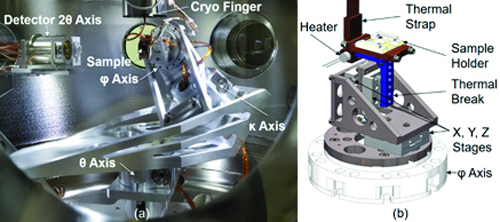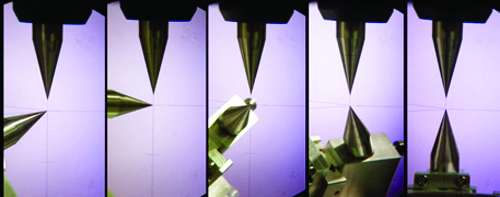
An ultra-high vacuum, non-magnetic kappa geometry diffractometer has been designed and commissioned for the resonant soft x-ray scattering (RSXS) branch of the X-ray Science Division (XSD) Intermediate Energy X-ray (IEX) beamline 29-ID at the Advanced Photon Source (APS). Beamline 29-ID is managed by the XSD Magnetic Materials Group; the APS is an Office of Science user facility at Argonne National Laboratory. There were three main design goals for this diffractometer: kappa geometry, non-magnetic, and high-precision. The kappa geometry was chosen to allow for a large q-range and space for a sample environment (electric or magnetic fields). Non-magnetic components were used for all the components above and including the κ-arm to avoid disturbing magnetic or electric fields during experiments. Lastly, the diffractometer precision requirement of a sphere of confusion (SOC) of less than 50 µm was a key driving factor for this instrument in terms of rotation stages and machining precision.
The complete diffractometer can be seen in Fig. 1(a), shown installed into the RSXS UHV vacuum chamber at 29-ID. The precise SOC (< 50 µm) requirement drove the design method. In order to reach this goal, it was decided that a combination of precision machining, Finite element analysis, and stage precision would be used instead of calibrating an error-correction table. This has the advantage that the upper bound of the SOC requirement can be achieved without any control hardware, making the device more robust.
The main arms of the q and k axes were machined from a single solid block of 6061 aluminum, which was then hardened to 6061-T6 to further add dimensional stability. Machining was performed on a high-precision, 5-axis milling machine with subsequent measurement in a coordinate measurement machine to ensure that the critical mounting planes were within 1 µm of the convergence point of the axes. Even with the high-precision machining, distortion from gravity had to be accounted for once the arms were loaded. Iterative finite-element analysis and balancing resulted in the complex shape shown for the arms. The side braces counteracted the loading distortion and kept the accuracy of the mounting planes. Lastly, the rotation stages for axes q and k (PRS-110, Physik Instrumente GmbH & Co.), and f (SR-7021, SmarAct GmbH) were chosen based on their wobble, flatness, and runout precision.
 Commissioning of the diffractometer was conducted in several phases: assembly and alignment in a clean room, followed by installation into the vacuum chamber, a second alignment to confirm the SOC was maintained, and cryogenic cooling of a test sample to 27 K. Alignment was performed using optical alignment telescopes and precision pins located at the convergence of axes. The final alignment accuracy can be seen in Fig. 2, which shows images of various rotation positions. The resolution of the alignment scope was 25 µm; therefore, the SOC achieved was less than 25 µm, a factor of 2 better than the design requirement.
Commissioning of the diffractometer was conducted in several phases: assembly and alignment in a clean room, followed by installation into the vacuum chamber, a second alignment to confirm the SOC was maintained, and cryogenic cooling of a test sample to 27 K. Alignment was performed using optical alignment telescopes and precision pins located at the convergence of axes. The final alignment accuracy can be seen in Fig. 2, which shows images of various rotation positions. The resolution of the alignment scope was 25 µm; therefore, the SOC achieved was less than 25 µm, a factor of 2 better than the design requirement.
Currently, the diffractometer is going through a slight upgrade of the cryogenic and thermal components. The new components can be seen Fig 1(b); these include a thicker thermal strap to reach sample temperatures of ≤ 20 K, a new thermal break made from Vespel® SP-1, and a redesigned cooling finger extension for better conductance and temperature measurement. Compared to the previous MACOR® thermal break, the new thermal break has a lower thermal conductivity above 1 K and is safer to use near x-rays in terms of maintaining the vacuum environment due to the release of fluorocarbons. Future plans also include pushing the SOC down to 5 µm by way of laser alignment or calibration of error correction tables.
Contact: Steven P. Kearney ([email protected])
See: Steven P. Kearney, Deming Shu, Fanny Rodolakis, Dohn Arms, Pete Jemian, and Jessica McChesney, “Mechanical design of a UHC non-magnetic kappa diffractometer,” AIP Conf. Proc. 2054, 060039. (2019). DOI: 10.1063/1.5084670
Author affiliation: Argonne National Laboratory
The authors would like to acknowledge Michael McDowell, Keenan Lang, and Joerg Strempfer of XSD for their help in commissioning this instrument, and the team at A.J.R. Industries, Inc., for the manufacturing effort. This research used resources of the Advanced Photon Source, a U.S. Department of Energy (DOE) Office of Science User Facility operated for the DOE Office of Science by Argonne National Laboratory under Contract No. DE-AC02-06CH11357.
The U.S. Department of Energy's APS is one of the world’s most productive x-ray light source facilities. Each year, the APS provides high-brightness x-ray beams to a diverse community of more than 5,000 researchers in materials science, chemistry, condensed matter physics, the life and environmental sciences, and applied research. Researchers using the APS produce over 2,000 publications each year detailing impactful discoveries, and solve more vital biological protein structures than users of any other x-ray light source research facility. APS x-rays are ideally suited for explorations of materials and biological structures; elemental distribution; chemical, magnetic, electronic states; and a wide range of technologically important engineering systems from batteries to fuel injector sprays, all of which are the foundations of our nation’s economic, technological, and physical well-being.
Argonne National Laboratory seeks solutions to pressing national problems in science and technology. The nation's first national laboratory, Argonne conducts leading-edge basic and applied scientific research in virtually every scientific discipline. Argonne researchers work closely with researchers from hundreds of companies, universities, and federal, state and municipal agencies to help them solve their specific problems, advance America's scientific leadership and prepare the nation for a better future. With employees from more than 60 nations, Argonne is managed by UChicago Argonne, LLC, for the U.S. DOE Office of Science.
The U.S. Department of Energy's Office of Science is the single largest supporter of basic research in the physical sciences in the United States and is working to address some of the most pressing challenges of our time. For more information, visit the Office of Science website.
